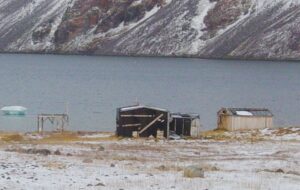 Sometimes, as in this case, Arctic and Antarctica are joined together in the bound by the invisible wire of radio waves . That WNP-WAP printed on a very old QSL card intrigues me a lot.
Sometimes, as in this case, Arctic and Antarctica are joined together in the bound by the invisible wire of radio waves . That WNP-WAP printed on a very old QSL card intrigues me a lot.
WNT-WAP of 1925 is something rare, nothing to do with WAP (Worldwide Antarctic Program) but it is still part of the passion that join the North and South Pole. This is why such an interesting info deserves to be published. The story shown here below, recalls the commitment of men and women as well as of institutions in exploring, studying and researching the secrets of our immeasurable planet.
We have to thank Mr. Terry Denton (carefreedentons@cox.net) who send us a QSL card which he has from the 1925 expedition.
Terry wrote: «This was in my late father’s collection. He worked in a small radio store in 1925 in Whitesboro, Texas. The card was addressed to his boss J.C. Bass at 106 Charter Street Whitesboro, Texas.  My father would have been 17 years of age at that time and his Ham activity is summarized as follows: The American Radio Relay League Amateur 5AFD 12/7/1925 to 12/31/1926 (his old QSL card on the right), then W5AFD 1/8/1932 to 1/7/1933 and W6KQX6 1/7/1946 to 6/7/1951. Later he was N6AHY»
My father would have been 17 years of age at that time and his Ham activity is summarized as follows: The American Radio Relay League Amateur 5AFD 12/7/1925 to 12/31/1926 (his old QSL card on the right), then W5AFD 1/8/1932 to 1/7/1933 and W6KQX6 1/7/1946 to 6/7/1951. Later he was N6AHY»
Theo “Ted” Denton was born in 1908 in Whitesboro, Texas. As a boy, like most of us, he became attracted to radio and what makes it work. The idea of having his own station empowered him to overcome the lack of any money or materials and he became successfully licensed as 5AFD about 1923. Like all radio amateurs of the day, he built his own equipment.
By 1928 he updated his exciter to a three stage Meissner design achieving contacts all around the U.S. His station became well known to locals and he was talked about and bragged about. As my grandmother relates: “Everyone who was anyone bragged about my Ted”.
By checking N6AHY on QRZ.com you can read all about Theo “Ted” Denton, a real pioneer on Ham radio. It’s always very nice to recall our colleagues who a century ago really were pioneers.
 Arctic Expedition 1925. The card was issued from contact at Etah, Greenland, but based upon the postage stamp it was mailed in Canada.
Arctic Expedition 1925. The card was issued from contact at Etah, Greenland, but based upon the postage stamp it was mailed in Canada.
Here a bit of history: 1925 Macmillan/Byrd Arctic Vessel WNP-WAP
The objectives supported by the Navy and the National Geographic Society were to determine the full capabilities of radio North of the auroral belt and to explore the Northern reaches by air. In the summer of 1925 the Bowdoin, captained by MacMillan led the Peary, a minesweeper enlisted as transport and captained by Zenith president Eugene F. McDonald, to a bay again near Etah in northern Greenland. Three amphibious aircraft were assembled on site and directed by Richard E. Byrd. Severely limited by weather and mechanical problems, the aircraft only accomplished some seven missions within their limited range, and did not actually fly over the pole. The outstanding accomplishment of the expedition was in the sphere of radio. Utilizing short waves, the expedition was in consistent contact with the outside world throughout the journey, to the delight of the amateurs who were able to work them. The phenomenal success proved to the Navy that short waves were definitely superior to the long and ultra long waves on which the fleets had been relying. 
Etah (see pic aside) is an abandoned settlement in the Qaasuitsup municipality in northern Greenland. It was was used in the past as a base camp for several Arctic expeditions, including Knud Rasmussen’s expeditions to the northern coast of Greenland and a starting point of discovery expeditions to the North Pole.
Etah was also the landing site of the last migration of the Inuit from the Canadian Arctic. The village was located on the shores of Foulk Fjord near Reindeer Point. The huts of the former village are still standing. Today, Etah is seldom visited
